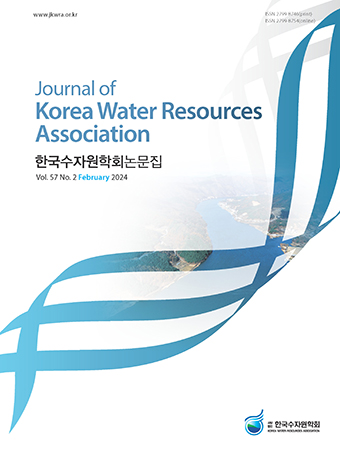Abstract
References
Abrahart, R.J., and See, L. (2000). “Comparing neural network and autoregressive moving average techniques for the provision of continuous river flow forecasts in two contrasting catchments, Hydrological Processes, Vol. 14, pp. 2157-2172. Akhtar, M.K., Corzo, G.A., van Andel, S.J., and Jonoski, A. (2009). “River fow forecasting with artificial neural networks using satellite observed precipitation pre-processed with flow length and travel time information: case study of the Ganges river basin.” Hydrology and Earth System Sciences, Vol. 13, pp. 1607-1618. Aldrich, C., Van Deventer, J.S.J., and Reuter, M.A. (1994). “The application of neural nets in the metallurgical industry.” Minerals Engineering, Vol. 7, pp. 793-809. ASCE: Task Committee on Application of Artificial Neural Networks in Hydrology (2000a). “Artificial Neural Networks in Hydrology, I: Preliminary Concepts.” Journal of Hydrologic Engineering, Vol. 5, No. 2, pp. 115-123. ASCE: Task Committee on Application of Artificial Neural Networks in Hydrology (2000b). “Artificial Neural Networks in Hydrology, II: Hydrology Application.” Journal of Hydrologic Engineering, Vol. 5, No. 2, pp. 124-136. Bailey, D.L., and Thompson, D.M. (1990). “Developing neural-network applications.” AI Expert, Vol. 5, No. 9, pp. 34-41. Barron, A.R. (1994). “Approximation and estimation bounds for artificial neural networks.” Machine Learning, Vol. 14, No., 1, pp. 115-133. Birkinshaw, S.J., O’Donnell, G.M., Moore, P., Kilsby, C.G., Fowler, H.J., and Berry, P.A.M. (2010). “Using satellite altimetry data to augment flow estimation techniques on the Mekong River.” Hydrological Processes, Vol. 24, No. 26, pp. 3811-3825. Bowden, G.J., Dandy, G.C., and Maier, H.R. (2005). “Input determination for neural network models in water resources applications. Part 1-background and methodology.” Journal of Hydrology, Vol. 301, No. 1-4, pp. 75-92. Brakenridge, G.R., Nghiem, S.V. Anderson, E., and Mic, R. (2007). “Orbital microwave measurement of river discharge and ice status.” Water Resources Research, Vol. 43, W04405. Chang, F., and Chen, Y. (2001). “A counterpropagation fuzzy-neural network modeling approach to real time streamflow prediction.” Journal of Hydrology, Vol. 245, No. 1-4, pp. 153-164. Cho, E., Moon, H., and Choi, M. (2015). “First Assessment of the Advanced Microwave Scanning Radiometer 2 (AMSR2) Soil Moisture Contents in Northeast Asia.” Journal of the Meteorological Society of Japan, Vol. 93, No. 1, pp. 117-129. De Groeve, T. (2010). “Flood monitoring and mapping using passive microwave remote sensing in Namibia.” Geomatics, Natural Hazards and Risk, Vol. 1, No. 1, pp. 19-35. Galelli, S., Humphrey, G.B., Maier, H.R., Castelletti, A., Dandy, G.C., and Gibbs M.S. (2014). “An evaluation framework for input variable selection algorithms for environmental data-driven models.” Environmental Modelling & Software, Vol. 65, pp. 33-51. Gnana Sheela, K., and Deepa, S.N. (2013). “Review on methods to fix number of hidden neurons in neural networks.” Mathematical Problems in Engineering, Vol. 2013. Hall, T., Brooks, H.E., Doswell III, C.A. (1999). “Precipitation forecasting using neural network.” Weather Forecast, Vol. 14, pp. 338-345. Han, K.H., Ryu, Y.J., Kim, T.S., and Heo, J.H. (2010). “Input variables selection of artificial neural network using mutual information.” Journal of the Korean Water Resources Association, Vol. 43, No. 1, pp. 81-94. Hirpa, F.A., Hopson, T.M., De Groeve, T., Brakenridge, G.R., Gebremichael, M., and Restrepo, P.J. (2013). “Upstream satellite remote sensing for river discharge forecasting: Application to major rivers in South Asia.” Remote Sensing of Environment, Vol. 131, pp. 140-151. Hopson, T.M., and Webster, P.J. (2010). “A 1-10-day ensemble for forecasting scheme for the major river basins of Bangladesh: Forecasting severe floods of 2003-07.” Journal of Hydrometeorology, Vol. 11, pp. 618-641. Jung, S. (2004). Artificial Intelligence System I Neural Network Structure and Instruction. Chungnam National University Press. Kaastra, I., and Boyd, M. (1996). “Designing a neural network for forecasting financial and economic time series.” Neurocomputing, Vol. 10, pp. 215-236. Kanellopoulas, I., and Wilkingson, G.G. (1997). “Strategies and best practice for neural network image classification.” International Journal of Remote Sensing, Vol. 18, No. 4, pp. 711-725. Kang, J.W. (2013). “Forecasting of seasonal inflow to reservoir using multiple linear regression.” Journal of Environmental Science International, Vol. 22, No. 8, pp. 953-963. Karimi, S., Kisi, O., Shiri, J., and Makarynskyy, O. (2013). “Neuro- fuzzy and neural network techniques for forecasting sea level in Darwin Harbor, Australia.” Computers and Geosciences, Vol. 52. pp. 50-59. Katz, J.O. (1992). “Developing neural network forecasters for trading.” Technical Analysis of Stocks and Commodities, Vol. 10, No. 4, pp. 160-168. Kim, C.Y., and Son, J.H. (2006). “A study on the model of artificial neural network for construction cost estimation of educational facilities at conceptual stage.” Korea Journal of Construction Engineering and Management, Vol. 7, No. 4, pp. 91-99. Kim, G.S. (2013). “Flood forecasting for a ungauged mountainous region using satellite data and ground multi-sensor data.” KSCE Annual Conference, Korean Society of Civil Engineers, pp. 2165-2168. Kim, G.S., and Brros, A.P. (2001). “Quantitative flood forecasting using multisensor data and neural networks.” Journal of Hydrology, Vol. 246, No. 1-4, pp. 45-62. Kim, H., and Choi, M. (2015). “Evaluation of satellite-based soil moisture retrieval over the korean peninsula: using AMSR2 LPRM algorithm and ground measurement data.” Journal of Korean Society of Hazard Mitigation, Vol. 15, No. 4, pp. 53-58. Kim, J.H., Lee, K.D., and Bae, D.H. (2003). “The coupled satellite rainfall-streamflow analysis on Imjin River basin.” KSCE Annual Conference, Korean Society of Civil Engineers, pp. 2305-2308. Kim, S., Kim, H., and Choi, M. (2015). “An Inter-comparison of Active and Passive satellite Soil Moisture Products in East Asia for Dust-Outbreak Prediction.” Journal of Korea Water Resources Association, Vol. 49, No. 5, pp. 423-429. Levenberg, K. (1944). “A method for the solution of certain non-linear problems in least squares.” Quarterly of Applied Mathematics, Vol. 2, No. 2, pp. 164-168. Maier, H.R., and Dandy, G.C. (1996). “The use of artificial neural networks for the prediction of water quality parameters.” Water Resources Research, Vol. 32, No. 4, pp. 1013-1022. May, R., Dandy, G., and Maier, H. (2011). “Review of Input Variable Selection Methods for Artificial Neural Networks.” Artificial Neural Networks-Methodological Advances and Biomedical Applications, Edited by Suzuki, K., InTech, India, pp. 19-44. May, R.J., Maier, H.R., Dandy, G.C., and Fernando, T.M.K.G. (2008). “Non-linear variable selection for artificial neural networks using partial mutual information.” Environmental Modelling & Software, Vol. 23, No. 10-11, pp. 1312-1326. McCulloch, W., Pitts, W. (1943). “A logical calculus of ideas immanent in nervous activity.” Bulletin of Mathematical Biophysics, Vol. 5, No. 4, pp. 115-133. Panchal, G., Ganatra, A., Kosta, Y.P., and Panchal, D. (2011). “Behaviour analysis of multilayer perceptrons with multiple hidden neurons and hidden layers.” International Journal of Computer Theory and Engineering, Vol. 3, No. 2, pp. 332-337. Park, J.A., and Kim, G.S. (2011). “Estimation of spatial distribution of soil moisture at Yongdam dam watershed using artificial neural networks.” Journal of the Korean Ceographical Society, Vol. 46, No. 3, pp. 319-330. Park, J.E., and Kim, S.H.(2013). “Application of Levenberg Marquardt method for calibration of unsteady friction model for pipeline system.” Journal of the Korean Water Resources Association, Vol. 46, No. 4, pp. 389-400. Revilla-Remero, B., Thielen, J., Salamon, P., De Groeve, T., and Brankenridge, G.R. (2014). “Evaluation of the satellite-based Global Flood Detection System for measuring river discharge: influence of local factors.” Hydrology and Earth System Sciences, Vol. 18, pp. 4467-4484. Sharma, A. (2000). “Seasonal to interannual rainfall probabilistic forecasts for improved water supply management: Part 1 – A strategy for system predictor identification.” Journal of Hydrology, Vol. 239, pp. 232-239
Information
- Publisher :KOREA WATER RESOURECES ASSOCIATION
- Publisher(Ko) :한국수자원학회
- Journal Title :Journal of Korea Water Resources Association
- Journal Title(Ko) :한국수자원학회 논문집
- Volume : 49
- No :7
- Pages :589-597
- Received Date : 2016-04-20
- Revised Date : 2016-05-09
- Accepted Date : 2016-05-13
- DOI :https://doi.org/10.3741/JKWRA.2016.49.7.589




 Journal of Korea Water Resources Association
Journal of Korea Water Resources Association










